Synchrony Bundle
How Does Synchrony Company Thrive in the Financial World?
Synchrony Financial, a prominent player in the financial services sector, facilitates billions in consumer purchases annually, making it a key entity in the retail credit landscape. The company offers a wide range of financial services, including credit cards and payment solutions, across various sectors such as retail, health, and home improvement. With a reported net earnings of $600 million for the fourth quarter of 2024, Synchrony demonstrates its significant financial scale and market presence, making it a compelling subject for financial analysis.
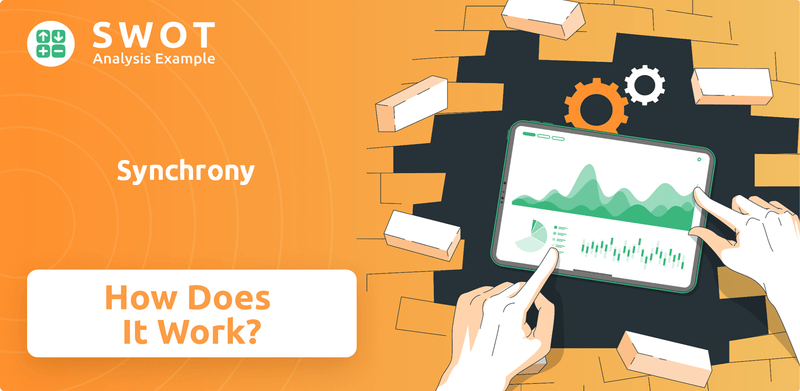
This exploration of Synchrony SWOT Analysis will uncover the inner workings of Synchrony Company, from its strategic partnerships to its financial products. Understanding how Synchrony Bank operates, including its credit card application process and payment options, is crucial for consumers and investors alike. We'll delve into Synchrony's role in retail partnerships, its rewards programs, interest rates, and fees, ultimately providing a comprehensive review of Synchrony Bank and its competitive standing within the financial services industry. Furthermore, we will explore topics such as Synchrony credit card customer service phone number, how to check your balance, and how to dispute a charge.
What Are the Key Operations Driving Synchrony’s Success?
Synchrony Financial, often referred to as Synchrony Company, operates primarily through a business-to-business-to-consumer (B2B2C) model, delivering value by offering various consumer credit products. These include private label credit cards, installment loans, and general-purpose credit cards. The company also provides promotional financing options to incentivize consumer spending across diverse customer segments.
The core of Synchrony's business revolves around its ability to provide flexible payment solutions. This includes offering financing for significant purchases, such as healthcare or home improvement, and providing options for everyday consumers seeking convenient payment methods. Its operational strategy is deeply rooted in technological innovation and strategic partnerships.
Synchrony's value proposition is centered on creating accessible financing solutions and driving increased sales for its partners. The company’s bespoke approach translates into significant customer benefits, offering accessible financing solutions and driving increased sales and customer loyalty for its partners, as highlighted in an article about the Target Market of Synchrony.
Synchrony offers a range of credit products, including private label cards, installment loans, and general-purpose credit cards. These products cater to diverse consumer needs, from everyday purchases to significant expenses. The company's financial services aim to provide flexible payment solutions for various customer segments.
Synchrony's operations are supported by advanced technology, data analytics, and strong partner management. The company utilizes proprietary credit decisioning platforms for real-time approvals. Integrated sales channels ensure seamless customer acquisition and engagement.
Synchrony enhances sales and customer loyalty for its partners by offering accessible financing. The company's tailored credit programs are designed for specific industry verticals. This approach provides significant customer benefits and drives increased sales.
In 2024, Synchrony reported a net earnings of approximately $2.7 billion. The company's total loan receivables were around $89 billion. Its focus on strategic partnerships and technological advancements continues to drive its financial performance.
Synchrony's success is built on several key operational strengths, including its advanced credit decisioning platforms and integrated sales channels. The company's ability to tailor credit programs to specific industries, such as healthcare, sets it apart. These factors contribute to its strong market position.
- Technology and Data: Utilizes proprietary platforms for real-time credit approvals.
- Partnerships: Leverages an extensive network of retail and healthcare partners.
- Customer Focus: Provides accessible financing solutions for diverse consumer needs.
- Financial Results: Achieved approximately $2.7 billion in net earnings in 2024.
Synchrony SWOT Analysis
- Complete SWOT Breakdown
- Fully Customizable
- Editable in Excel & Word
- Professional Formatting
- Investor-Ready Format
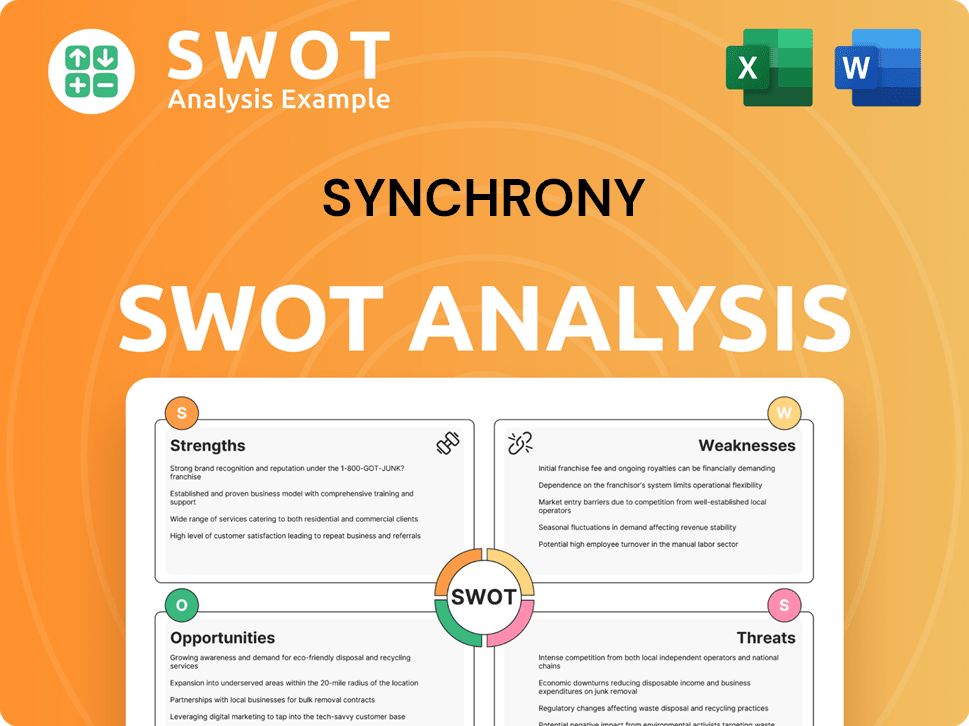
How Does Synchrony Make Money?
The Synchrony Company, also known as Synchrony Financial, generates revenue through a multifaceted approach, primarily centered on financial services. Their core business revolves around providing credit cards and payment solutions. Understanding their revenue streams is key to grasping how Synchrony Bank operates and sustains its financial performance.
The company's monetization strategies are designed to maximize profitability across its diverse portfolio of accounts and partnerships. These strategies include interest income, interchange fees, and various other fees, which contribute to the financial health of Synchrony Financial. The company's innovative approaches also involve promotional financing offers and data analytics to optimize credit offerings.
The primary revenue stream for Synchrony Financial is net interest income, derived from the difference between the interest earned on its credit card and loan receivables and the interest paid on its funding sources. For the full year 2024, Synchrony reported net interest income of $15.5 billion, a significant portion of its total revenue. This demonstrates the importance of interest income in their business model.
In addition to net interest income, Synchrony earns revenue through interchange fees, which are fees merchants pay for processing transactions on Synchrony credit cards. Other fees, such as late fees and annual fees, also contribute to the company's revenue. Synchrony leverages promotional financing offers to drive transaction volume and partner loyalty, contributing to long-term revenue growth. To understand how Synchrony Bank works, it's important to recognize these diverse revenue sources.
- Net Interest Income: The largest revenue source, derived from interest on loans.
- Interchange Fees: Fees charged to merchants for processing transactions.
- Other Fees: Includes late fees, annual fees, and servicing fees.
- Promotional Financing: Strategies to incentivize spending and drive transaction volume.
- Data Analytics: Used to optimize credit offerings and pricing.
Synchrony PESTLE Analysis
- Covers All 6 PESTLE Categories
- No Research Needed – Save Hours of Work
- Built by Experts, Trusted by Consultants
- Instant Download, Ready to Use
- 100% Editable, Fully Customizable
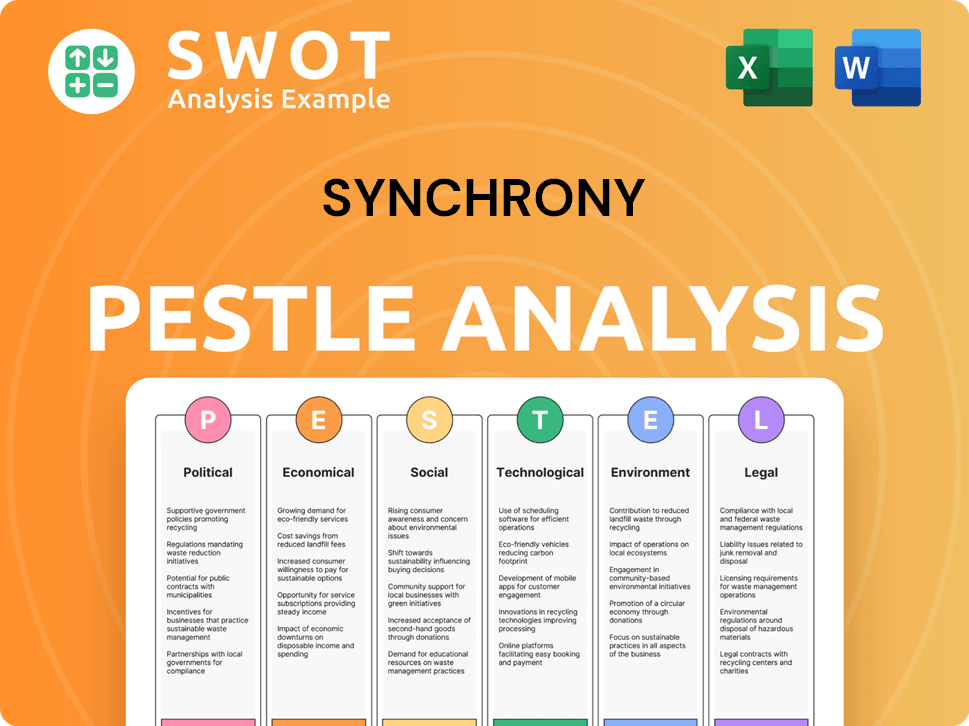
Which Strategic Decisions Have Shaped Synchrony’s Business Model?
The journey of Synchrony Financial has been marked by pivotal moments and strategic shifts. A key milestone was its spin-off from GE Capital in 2014. This allowed Synchrony Bank to operate independently, focusing solely on consumer finance. Recent strategic moves involve emphasizing partnerships and technological advancements.
In 2024, Synchrony announced renewed partnerships with retailers, strengthening its position in the retail credit space. The company continues to invest in digital capabilities, enhancing its mobile app and online tools. This improves customer experience and streamlines operations. These steps are crucial for adapting to the evolving financial landscape.
Operational challenges include managing credit quality and adapting to regulatory changes. Synchrony addresses these by implementing robust risk management and diversifying its portfolio. Its competitive advantages are multifaceted, including brand strength, technology leadership, and economies of scale. For a deeper dive into the company's expansion, you can read about the Growth Strategy of Synchrony.
The 2014 spin-off from GE Capital was a transformative event. This allowed Synchrony Financial to operate as an independent entity. The move enabled a focused approach on consumer finance and strategic growth.
Synchrony Bank has emphasized strategic partnerships, such as the 2024 agreements with retailers. Investments in digital capabilities are ongoing. These moves aim to enhance customer experience and streamline operations.
Synchrony benefits from brand strength, especially with CareCredit. Technology leadership in credit decisioning and servicing is a key advantage. Economies of scale and strong partner ecosystems further enhance its competitive position.
Managing credit quality and adapting to regulatory changes are ongoing challenges. Synchrony uses robust risk management frameworks and portfolio diversification. The company explores opportunities in digital payments to sustain its business model.
Synchrony Financial reported a net earnings of $1.8 billion for the year 2024. This reflects its strong market position and effective risk management. The company's loan receivables reached approximately $89 billion by the end of 2024.
- Synchrony Bank maintains a significant market share in private label credit cards.
- The company's focus on digital innovation has led to increased customer engagement.
- Partnerships with major retailers contribute substantially to its revenue streams.
- Synchrony's diversified portfolio helps mitigate risks associated with economic cycles.
Synchrony Business Model Canvas
- Complete 9-Block Business Model Canvas
- Effortlessly Communicate Your Business Strategy
- Investor-Ready BMC Format
- 100% Editable and Customizable
- Clear and Structured Layout
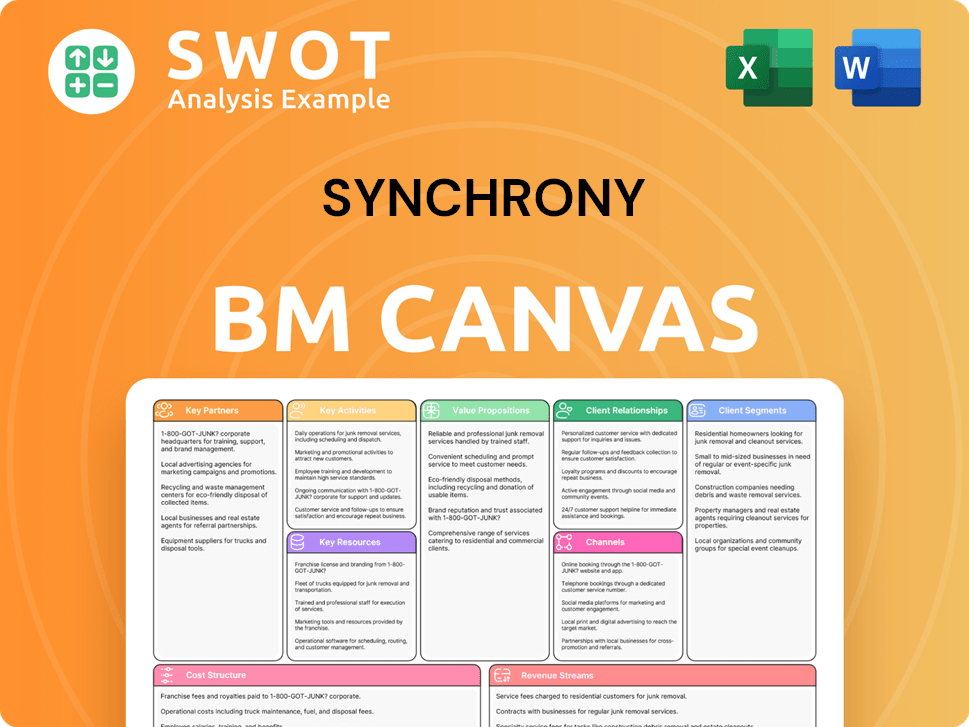
How Is Synchrony Positioning Itself for Continued Success?
Let's explore the industry position, risks, and future outlook of Synchrony Financial. Synchrony holds a strong position in the U.S. consumer finance sector, particularly in private label credit cards and promotional financing. Its long-standing relationships with major retailers and healthcare providers contribute to its significant market share. Synchrony's focus is primarily on the U.S. market, but its digital capabilities allow for broader accessibility.
Synchrony faces several risks. Regulatory changes and new competitors, including fintech startups, could impact its operations. Technological advancements and changing consumer preferences also pose potential challenges. The company is actively working to innovate and adapt to these shifts.
Synchrony Financial is a major player in the U.S. consumer finance market. It specializes in private label credit cards and promotional financing, maintaining strong partnerships with retailers. The company's customer loyalty is often tied to the specific retail brands it partners with.
Synchrony faces risks such as regulatory changes and competition from fintech companies. Technological disruptions and shifts in consumer preferences also present challenges. These factors could affect Synchrony's market share and profitability.
Synchrony is focusing on expanding digital payment solutions and investing in AI. The company aims to drive sustainable growth through innovation and deepening partner relationships. It plans to continue offering tailored credit solutions and exploring new market opportunities.
Synchrony is expanding its digital payment solutions and investing in AI and machine learning. The company is also focused on diversifying its partner ecosystem to drive growth. Leadership is committed to innovation and strengthening partner relationships.
Synchrony's strategic initiatives include expanding digital payment solutions and investing in AI. The company is also diversifying its partner ecosystem. Looking forward, Synchrony plans to continue offering tailored credit solutions and exploring new avenues for embedded finance. For more details, read this article about Synchrony.
Synchrony's performance is closely tied to consumer spending and economic conditions. Regulatory changes and the rise of alternative payment methods are key areas to watch. The company's ability to adapt to these changes will determine its future success.
- Synchrony's net charge-offs rate was 2.9% in Q1 2024.
- Purchase volume increased by 3% year-over-year in Q1 2024.
- Synchrony's digital sales accounted for 20% of total sales in 2024.
- The company's strategic partnerships are expected to drive 5% growth in new accounts.
Synchrony Porter's Five Forces Analysis
- Covers All 5 Competitive Forces in Detail
- Structured for Consultants, Students, and Founders
- 100% Editable in Microsoft Word & Excel
- Instant Digital Download – Use Immediately
- Compatible with Mac & PC – Fully Unlocked
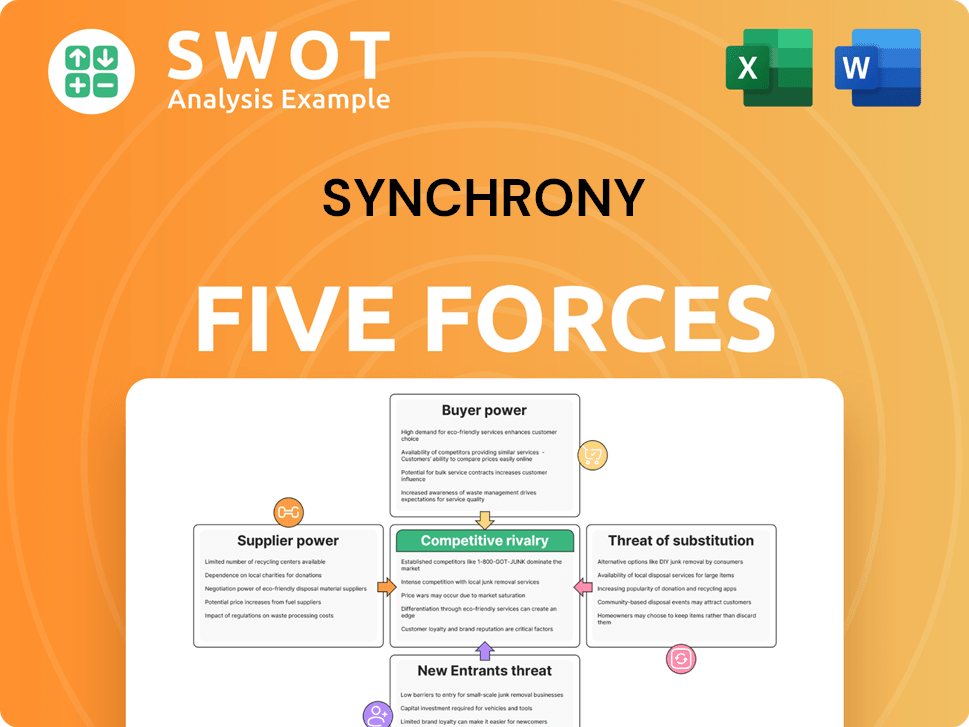
Related Blogs
- What are Mission Vision & Core Values of Synchrony Company?
- What is Competitive Landscape of Synchrony Company?
- What is Growth Strategy and Future Prospects of Synchrony Company?
- What is Sales and Marketing Strategy of Synchrony Company?
- What is Brief History of Synchrony Company?
- Who Owns Synchrony Company?
- What is Customer Demographics and Target Market of Synchrony Company?
Disclaimer
All information, articles, and product details provided on this website are for general informational and educational purposes only. We do not claim any ownership over, nor do we intend to infringe upon, any trademarks, copyrights, logos, brand names, or other intellectual property mentioned or depicted on this site. Such intellectual property remains the property of its respective owners, and any references here are made solely for identification or informational purposes, without implying any affiliation, endorsement, or partnership.
We make no representations or warranties, express or implied, regarding the accuracy, completeness, or suitability of any content or products presented. Nothing on this website should be construed as legal, tax, investment, financial, medical, or other professional advice. In addition, no part of this site—including articles or product references—constitutes a solicitation, recommendation, endorsement, advertisement, or offer to buy or sell any securities, franchises, or other financial instruments, particularly in jurisdictions where such activity would be unlawful.
All content is of a general nature and may not address the specific circumstances of any individual or entity. It is not a substitute for professional advice or services. Any actions you take based on the information provided here are strictly at your own risk. You accept full responsibility for any decisions or outcomes arising from your use of this website and agree to release us from any liability in connection with your use of, or reliance upon, the content or products found herein.